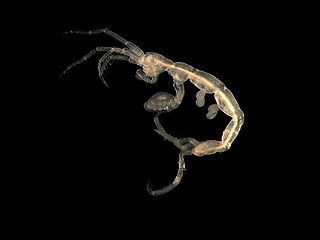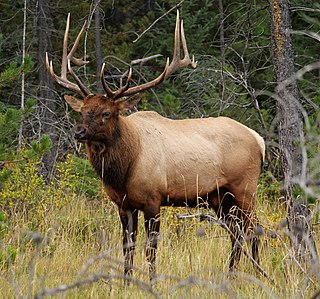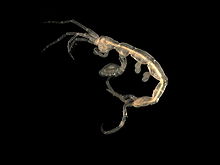
Foxes are small to medium-sized, omnivorous mammals belonging to several genera of the family Canidae. They have a flattened skull, upright, triangular ears, a pointed, slightly upturned snout, and a long bushy tail ("brush").

The orca, also called killer whale, is a toothed whale belonging to the oceanic dolphin family, of which it is the largest member. It is the only extant species in the genus Orcinus and is recognizable by its black-and-white patterned body. A cosmopolitan species, orcas can be found in all of the world's oceans in a variety of marine environments, from Arctic and Antarctic regions to tropical seas.

A lynx is any of the four species within the medium-sized wild cat genus Lynx. The name originated in Middle English via Latin from the Greek word lynx (λύγξ), derived from the Indo-European root leuk-, in reference to the luminescence of its reflective eyes.

Squirrels are members of the family Sciuridae, a family that includes small or medium-size rodents. The squirrel family includes tree squirrels, ground squirrels, and flying squirrels. Squirrels are indigenous to the Americas, Eurasia, and Africa, and were introduced by humans to Australia. The earliest known fossilized squirrels date from the Eocene epoch, and among other living rodent families, the squirrels are most closely related to the mountain beaver and to the dormice.

Scorpions are predatory arachnids of the order Scorpiones. They have eight legs, and are easily recognized by a pair of grasping pincers and a narrow, segmented tail, often carried in a characteristic forward curve over the back and always ending with a stinger. The evolutionary history of scorpions goes back 435 million years. They mainly live in deserts but have adapted to a wide range of environmental conditions, and can be found on all continents except Antarctica. There are over 2,500 described species, with 22 extant (living) families recognized to date. Their taxonomy is being revised to account for 21st-century genomic studies.

An oak is a tree or shrub in the genus Quercus of the beech family, Fagaceae. There are approximately 500 extant species of oaks. The common name "oak" also appears in the names of species in related genera, notably Lithocarpus, as well as in those of unrelated species such as Grevillea robusta and the Casuarinaceae (she-oaks). The genus Quercus is native to the Northern Hemisphere and includes deciduous and evergreen species extending from cool temperate to tropical latitudes in the Americas, Asia, Europe, and North Africa. North America has the largest number of oak species, with approximately 160 species in Mexico, of which 109 are endemic and about 90 in the United States. The second greatest area of oak diversity is China, with approximately 100 species.

Sharks are a group of elasmobranch fish characterized by a cartilaginous skeleton, five to seven gill slits on the sides of the head, and pectoral fins that are not fused to the head. Modern sharks are classified within the clade Selachimorpha and are the sister group to the Batoidea. Some sources extend the term "shark" as an informal category including extinct members of Chondrichthyes with a shark-like morphology, such as hybodonts. Shark-like chondrichthyans such as Cladoselache and Doliodus first appeared in the Devonian Period, though some fossilized chondrichthyan-like scales are as old as the Late Ordovician. The oldest modern sharks (selachians) are known from the Early Jurassic, about 200 Ma.

A tuna is a saltwater fish that belongs to the tribe Thunnini, a subgrouping of the Scombridae (mackerel) family. The Thunnini comprise 15 species across five genera, the sizes of which vary greatly, ranging from the bullet tuna up to the Atlantic bluefin tuna, which averages 2 m (6.6 ft) and is believed to live up to 50 years.

Extinction is the termination of a taxon by the death of its last member. A taxon may become functionally extinct before the death of its last member if it loses the capacity to reproduce and recover. Because a species' potential range may be very large, determining this moment is difficult, and is usually done retrospectively. This difficulty leads to phenomena such as Lazarus taxa, where a species presumed extinct abruptly "reappears" after a period of apparent absence.

Eucalyptus is a genus of more than 700 species of flowering plants in the family Myrtaceae. Most species of Eucalyptus are trees, often mallees and a few are shrubs. Along with several other genera in the tribe Eucalypteae, including Corymbia and Angophora, they are commonly known as eucalypts. Plants in the genus Eucalyptus have bark that is either smooth, fibrous, hard or stringy, the leaves have oil glands, and the sepals and petals are fused to form a "cap" or operculum over the stamens. The fruit is a woody capsule commonly referred to as a "gumnut".

Herring are forage fish, mostly belonging to the family of Clupeidae.

Marmots are large ground squirrels in the genus Marmota, with 15 species living in Asia, Europe, and North America. These herbivores are active during the summer, when they can often be found in groups, but are not seen during the winter, when they hibernate underground. They are the heaviest members of the squirrel family.

Caprellidae is a family of amphipods commonly known as skeleton shrimps. Their common name denotes the threadlike slender body which allows them to virtually disappear among the fine filaments of seaweed, hydroids and bryozoans. They are sometimes also known as ghost shrimps.

Malaysia is a country in Southeast Asia. The federal constitutional monarchy consists of thirteen states and three federal territories, separated by the South China Sea into two regions: Peninsular Malaysia and Borneo's East Malaysia. Peninsular Malaysia shares a land and maritime border with Thailand and maritime borders with Singapore, Vietnam, and Indonesia. East Malaysia shares land and maritime borders with Brunei and Indonesia, as well as a maritime border with the Philippines and Vietnam. Kuala Lumpur is the national capital, the country's largest city, and the seat of the legislative branch of the federal government. Putrajaya is the country's administrative centre, which represents the seat of both the executive branch and the judicial branch of the federal government. With a population of over 33 million, The country is the world's 43rd-most populous country. The southernmost point of continental Eurasia is Tanjung Piai. Located in the tropics, the country is one of 17 megadiverse countries and home to numerous endemic species.

A flower, sometimes known as a bloom or blossom, is the reproductive structure found in flowering plants. Flowers produce gametophytes, which in flowering plants consist of a few haploid cells which produce gametes. The "male" gametophyte, which produces non-motile sperm, is enclosed within pollen grains; the "female" gametophyte is contained within the ovule. When pollen from the anther of a flower is deposited on the stigma, this is called pollination. Some flowers may self-pollinate, producing seed using pollen from the same flower or a different flower of the same plant, but others have mechanisms to prevent self-pollination and rely on cross-pollination, when pollen is transferred from the anther of one flower to the stigma of another flower on a different individual of the same species.

The elk, or wapiti, is one of the largest species within the deer family, Cervidae, and one of the largest terrestrial mammals in its native range of North America and Central and East Asia. The word "elk" originally referred to the European variety of the moose, Alces alces, but was transferred to Cervus canadensis by North American colonists. The name "wapiti", derived from a Shawnee and Cree word meaning "white rump" for the distinctive light fur in the rear region.

Great Britain is an island in the North Atlantic Ocean off the north-west coast of continental Europe, consisting of England, Scotland and Wales. With an area of 209,331 km2 (80,823 sq mi), it is the largest of the British Isles, the largest European island and the ninth-largest island in the world. It is dominated by a maritime climate with narrow temperature differences between seasons. The island of Ireland, with an area 40 per cent that of Great Britain, is to the west—these islands, along with over 1,000 smaller surrounding islands and named substantial rocks, form the British Isles archipelago.

Pariambus typicus is a species of amphipod crustacean. It is found in the Atlantic Ocean from northern Norway south to the Cape Verde Islands and into the Mediterranean Sea as far east as Italy. It is absent from the Baltic Sea, suggesting that it requires water of high salinity. Adults grow to a length of 7 millimetres (0.28 in), and are commonly found in association with starfish and sea urchins, and more rarely with brittle stars. The species is sometimes included in the family Pariambidae, but more usually in the Caprellidae.
The Plant List was a list of botanical names of species of plants created by the Royal Botanic Gardens, Kew and the Missouri Botanical Garden and launched in 2010. It was intended to be a comprehensive record of all known names of plant species over time, and was produced in response to Target 1 of the 2002–2010 Global Strategy for Plant Conservation, to produce "An online flora of all known plants". It has not been updated since 2013, and has been superseded by World Flora Online.

A shrimp is a crustacean with an elongated body and a primarily swimming mode of locomotion – typically belonging to the Caridea or Dendrobranchiata of the decapod order, although some crustaceans outside of this order are also referred to as "shrimp".


















